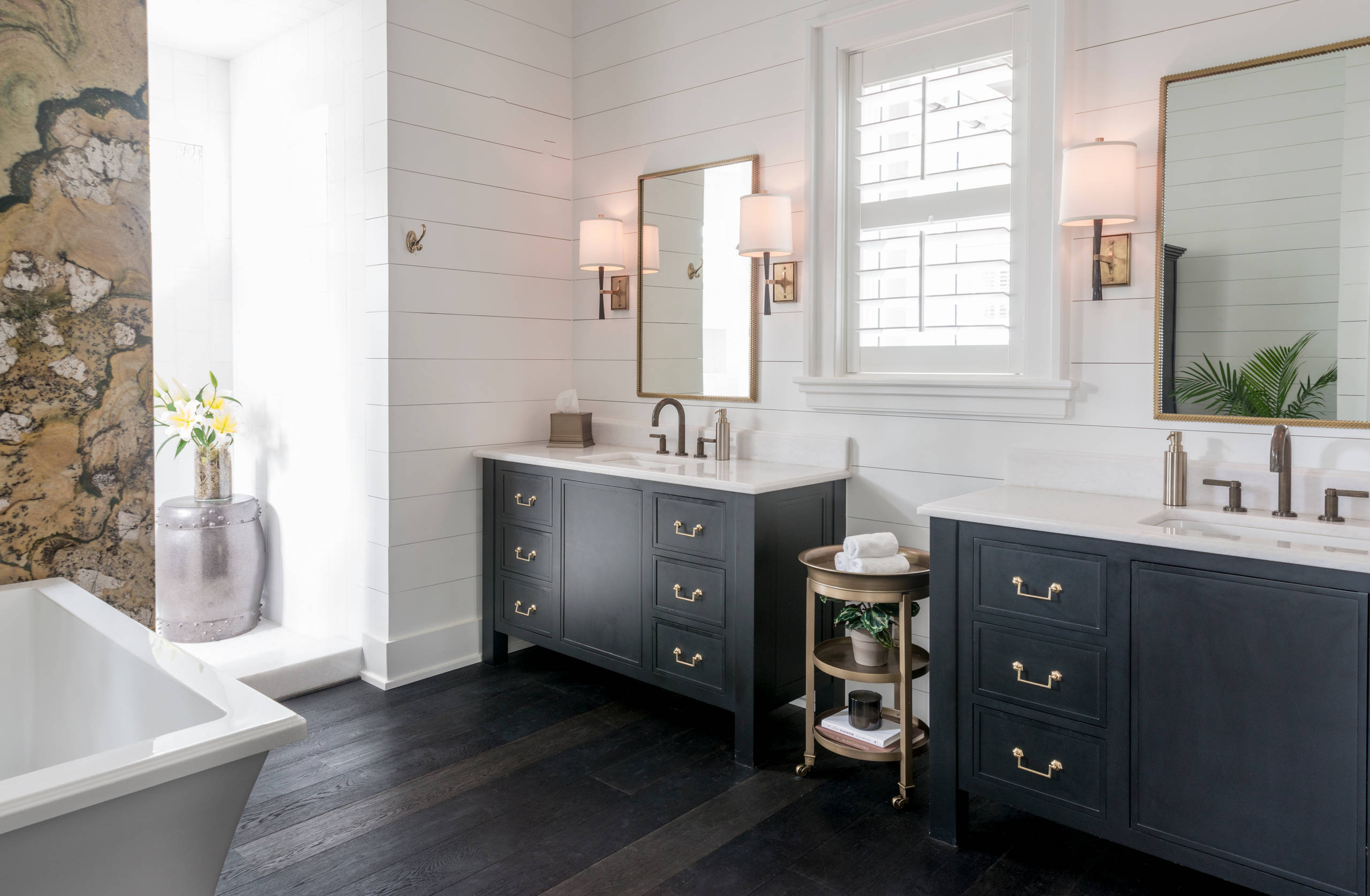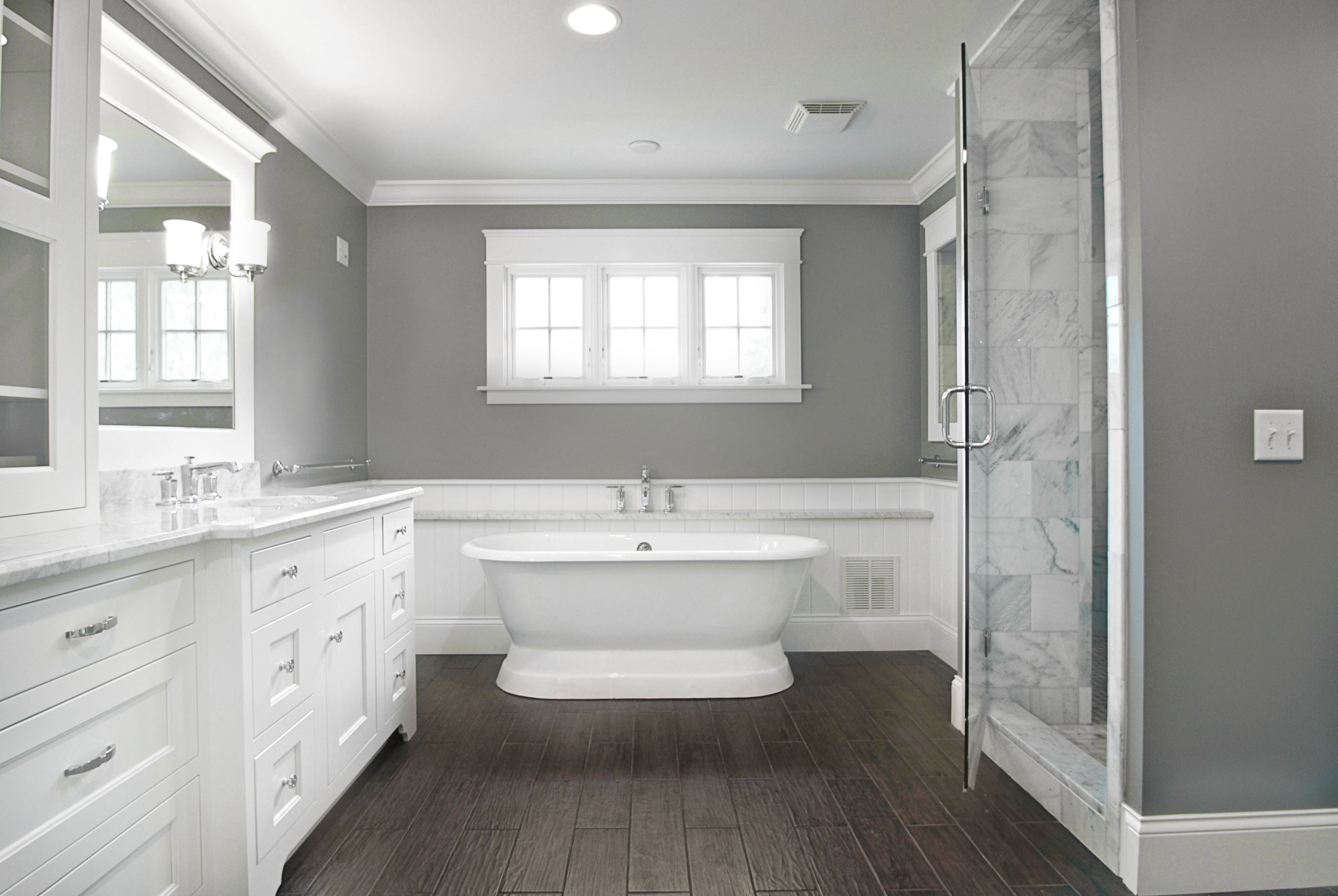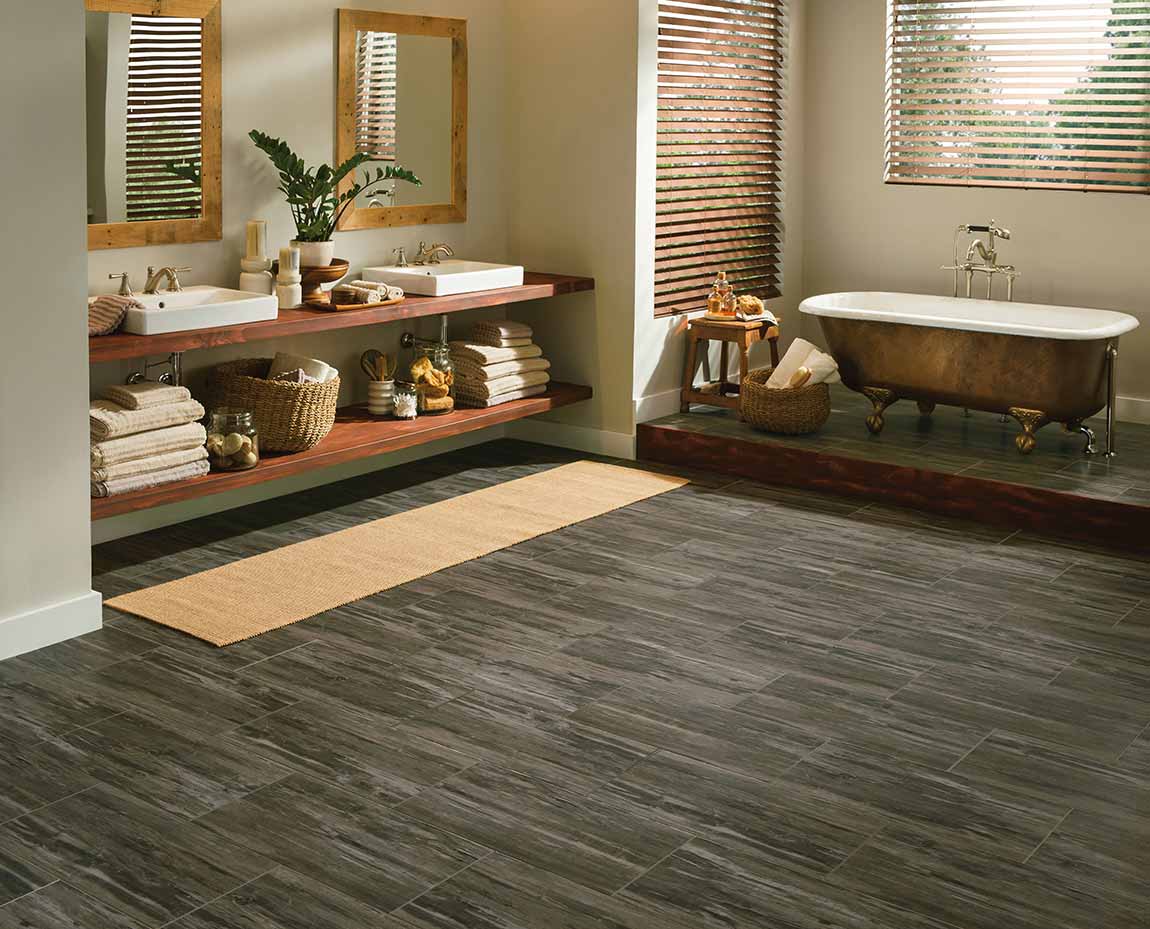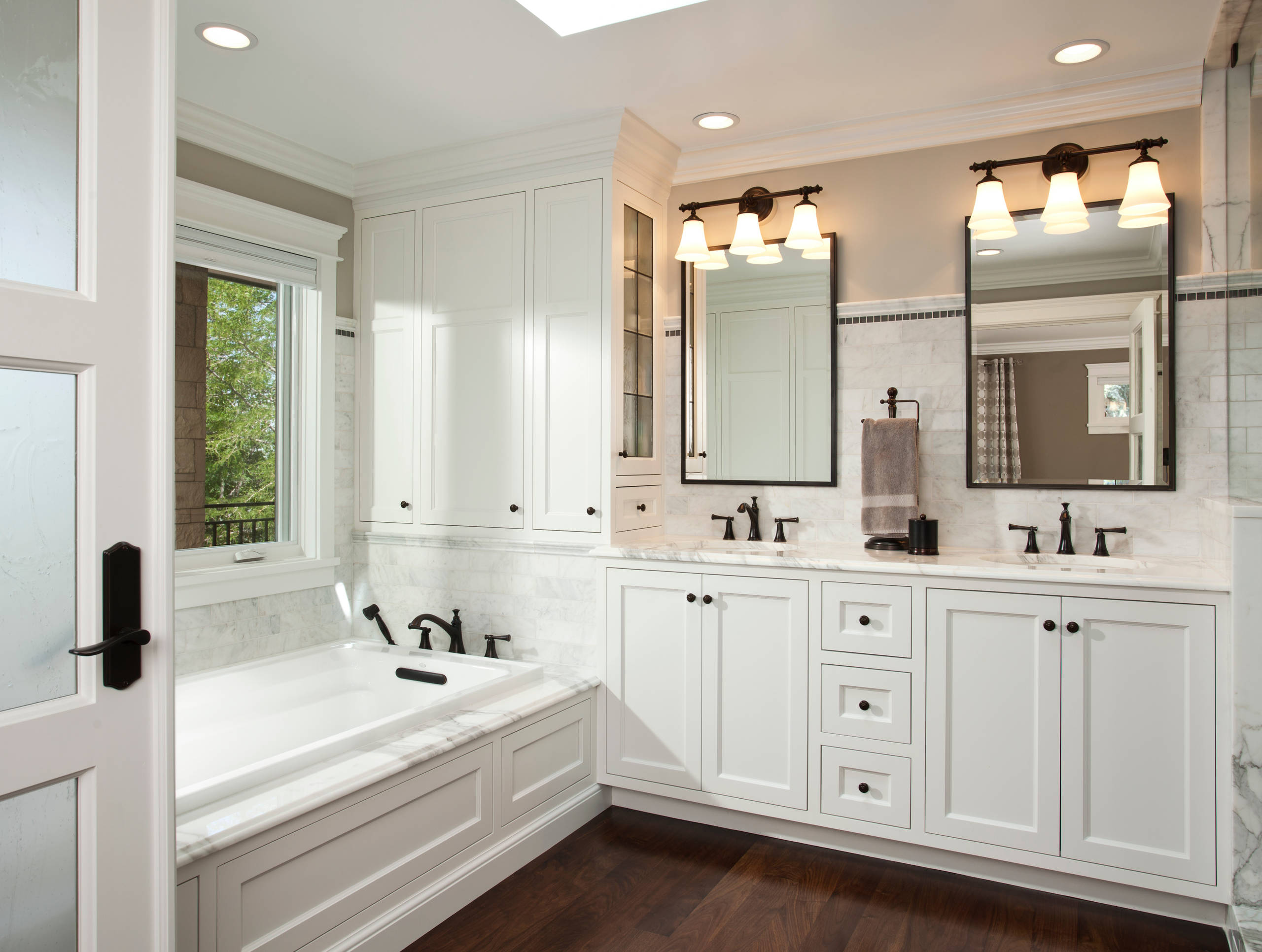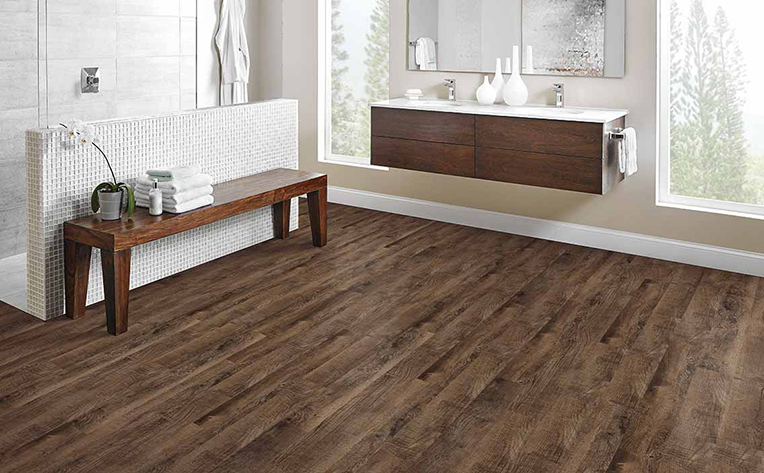Benefits of Choosing Dark Wood for Bathroom Floors
Dark wood flooring in a bathroom can elevate the aesthetic appeal, adding a touch of luxury and warmth. This choice offers several practical and visual benefits that can make your bathroom a standout space.
- Luxurious Aesthetic: Dark wood floors exude a sense of sophistication and luxury. They can transform an ordinary bathroom into an elegant retreat. The deep hues create a rich, inviting atmosphere, making the space feel more upscale and refined.
- Versatile Design Compatibility: Dark wood is incredibly versatile and can complement various design styles, from modern to traditional. Whether you’re aiming for a minimalist, contemporary look or a classic, rustic feel, dark wood flooring can seamlessly fit into your vision.
- Enhanced Contrast: Dark wood floors provide a beautiful contrast to lighter bathroom fixtures and walls. This contrast can highlight the unique features of your bathroom, such as a white porcelain bathtub or marble countertops, making these elements stand out more prominently.
- Conceals Dirt and Scratches: Darker wood tones are better at hiding dirt, dust, and minor scratches compared to lighter flooring options. This can be particularly advantageous in a high-traffic area like a bathroom, where maintaining a spotless appearance can be challenging.
- Warmth and Comfort: Dark wood adds a sense of warmth and coziness to the bathroom. Unlike tiles, which can be cold underfoot, wood floors feel warmer and more comfortable, enhancing the overall comfort of the space.
- Increased Property Value: Installing darkwood floors can potentially increase the value of your home. Many buyers are attracted to the timeless appeal and durability of wood flooring, seeing it as a desirable feature that adds long-term value.

Types of Dark Wood Suitable for Bathroom Use
When selecting dark wood flooring for a bathroom, it’s important to choose types that can withstand the moisture and humidity typical of the environment. Here are some suitable options that combine beauty with resilience.
Teak: Teak is an excellent choice for bathroom floors due to its high natural oil content, which makes it highly resistant to water and moisture. Its durability and rich, dark hue add elegance to any bathroom setting. Teak is also resistant to mold and mildew, making it a practical option.
Mahogany: Mahogany’s deep, reddish-brown color and fine grain pattern offer a luxurious feel. It is known for its stability and resistance to water damage. Mahogany can handle the humid conditions of a bathroom, maintaining its beauty and integrity over time.
Engineered Wood: Engineered wood is a great alternative to solid hardwood for bathrooms. It consists of a plywood base with a hardwood veneer, providing enhanced stability and resistance to moisture. You can find engineered wood in various dark finishes, allowing you to achieve the desired aesthetic.
Bamboo: Strand-woven bamboo is another suitable option for bathroom flooring. Although not a traditional wood, bamboo is incredibly durable and water-resistant, especially when properly treated. Its dark, rich tones can mimic the appearance of hardwood while offering superior performance in wet environments.
Oak: Oak, particularly white oak, is a strong and dense wood that can handle bathroom conditions well. Dark-stained oak offers a classic look and is less likely to warp or swell with humidity. Its natural resistance to moisture makes it a reliable choice.
Walnut: Walnut features a rich, dark brown color with stunning grain patterns. While it is softer than some other hardwoods, with proper sealing and maintenance, walnut can be used in bathrooms. Its luxurious appearance can add a touch of sophistication to the space.
Design Ideas for Incorporating Dark Wood Floors in Bathrooms
Dark wood floors can serve as a stunning foundation for various bathroom design styles. Here are some creative ideas to help you incorporate dark wood floors into your bathroom design effectively.
Modern Minimalist: Pair dark wood floors with sleek, white fixtures and minimal decor to create a modern, minimalist bathroom. The contrast between the dark flooring and the white elements will make the space feel clean and sophisticated. Add stainless steel or chrome accents for a contemporary touch.
Rustic Charm: Embrace a rustic aesthetic by combining dark wood floors with natural materials like stone and reclaimed wood. Use a freestanding, clawfoot bathtub and vintage-inspired fixtures to enhance the rustic charm. Soft, earthy tones for walls and accessories will complement the wood’s rich hue.
Spa-Like Retreat: Transform your bathroom into a spa-like retreat by incorporating dark wood floors with soothing, neutral colors and natural textures. Use soft lighting, lush green plants, and luxurious linens to create a relaxing ambiance. Consider a wooden bath mat or teak shower bench to tie the look together.
Classic Elegance: For a timeless and elegant bathroom, pair dark wood floors with classic elements like a marble countertop and ornate fixtures. Use a deep, rich wall color to enhance the luxurious feel. Add vintage mirrors and crystal chandeliers for a touch of opulence.
Coastal Vibes: Create a coastal-inspired bathroom by blending dark wood floors with light blue or aqua walls and white fixtures. Incorporate natural elements like seashells, coral, and driftwood accessories. Use soft, breezy fabrics for window treatments and towels to complete the beachy look.
Industrial Chic: Achieve an industrial chic aesthetic by combining dark wood floors with exposed brick walls, metal fixtures, and concrete countertops. Use black or dark gray accents to complement the wood’s depth. Industrial-style lighting and open shelving can enhance the edgy, urban feel.
Installation Tips for Dark Wood Bathroom Flooring
Installing dark wood flooring in a bathroom requires careful planning and execution to ensure longevity and performance. Follow these tips for a successful installation.
Choose the Right Wood and Finish: Select a wood species and finish that is suitable for bathroom conditions. Engineered wood or moisture-resistant hardwoods like teak and mahogany are ideal choices. Ensure the finish is water-resistant to protect the wood from moisture damage.
Acclimate the Wood: Before installation, allow the wood planks to acclimate to the bathroom’s environment for at least 48 hours. This helps prevent expansion or contraction after installation. Place the unopened boxes of wood in the bathroom to adjust to the room’s temperature and humidity.
Prepare the Subfloor: Ensure the subfloor is clean, dry, and level. Remove any existing flooring and repair any damage to the subfloor. Install a moisture barrier to protect the wood from moisture rising from the subfloor. A properly prepared subfloor is essential for a stable installation.
Use a Suitable Underlayment: Install an underlayment that provides additional moisture protection and sound insulation. This layer helps to cushion the wood planks and reduce noise. Follow the manufacturer’s instructions for installing the underlayment.
Leave Expansion Gaps: Wood flooring needs space to expand and contract with changes in humidity and temperature. Leave an expansion gap of at least 1/4 inch around the perimeter of the room and any fixtures. Use spacers during installation to maintain consistent gaps.
Secure the Planks Properly: For floating installations, use a click-lock system to secure the planks together. For nail-down or glue-down methods, follow the manufacturer’s guidelines to ensure a secure fit. Make sure each plank is properly aligned and secured before moving to the next.
Seal the Edges: After installation, apply a silicone sealant around the edges of the room, especially around fixtures like the toilet and bathtub. This helps prevent water from seeping under the wood and causing damage. Ensure the sealant is applied smoothly and consistently.
Finish with Baseboards: Install baseboards to cover the expansion gaps and provide a finished look. Choose baseboards that complement the dark wood flooring and secure them tightly against the wall. Seal any gaps between the baseboards and the floor with silicone sealant.
Maintaining and Cleaning Dark Wood Bathroom Floors
Maintaining dark wood floors in a bathroom involves specific care routines to preserve their beauty and functionality. Here are some tips for keeping your darkwood bathroom floors in pristine condition.
Regular Cleaning: Sweep or vacuum the floor regularly to remove dust and dirt that can scratch the surface. Use a soft-bristle broom or a vacuum cleaner with a hard floor setting to avoid damaging the wood. Regular cleaning prevents abrasive particles from accumulating.
Immediate Spill Management: Promptly wipe up any spills to prevent water damage. Use a dry or slightly damp cloth to clean up spills, and avoid letting water sit on the floor. Immediate spill management is crucial in a bathroom setting where water exposure is frequent.
Use a Damp Mop: When mopping the floor, use a damp mop rather than a wet one. Excess water can seep into the wood and cause swelling or warping. Choose a cleaner specifically designed for wood floors and follow the manufacturer’s instructions for dilution and application.
Protect from Moisture: Use mats and rugs in areas prone to water exposure, such as near the bathtub and sink. Ensure these mats have non-slip backings to prevent accidents. Avoid rubber-backed mats, as they can trap moisture and damage the wood surface.
Maintain Humidity Levels: Bathrooms can become humid, which can affect wood flooring. Use exhaust fans or dehumidifiers to maintain optimal humidity levels. Keeping the bathroom well-ventilated helps prevent moisture buildup and protects the wood from swelling or warping.
Regular Inspections: Periodically inspect your wood floors for signs of wear or damage, such as scratches, cracks, or warping. Address any issues promptly to prevent further damage. Regular inspections help you catch and fix problems early, maintaining the floor’s appearance and integrity.
Apply Protective Coatings: Consider applying a protective coating or sealant to enhance the wood’s resistance to moisture and wear. Follow the manufacturer’s recommendations for reapplication intervals to ensure ongoing protection. A well-maintained sealant can extend the life of your wood floors.
Avoid Harsh Chemicals: Use gentle, wood-specific cleaning products and avoid harsh chemicals that can strip the finish. Products containing ammonia, bleach, or abrasive cleaners can damage the wood’s surface and finish. Stick to mild, pH-balanced cleaners for routine maintenance.
Comparing Dark Wood Flooring to Other Bathroom Flooring Options
When choosing bathroom flooring, it’s important to weigh the pros and cons of different materials. Here’s how dark wood flooring compares to other popular bathroom flooring options.
Dark Wood vs. Tile: Tile is a common choice for bathrooms due to its durability and water resistance. However, dark wood offers a warmer and more inviting look compared to the cold, hard feel of tile. While tile can handle water better, engineered wood or properly sealed hardwood can provide a comparable level of moisture resistance with added aesthetic appeal.
Dark Wood vs. Vinyl: Vinyl flooring is highly water-resistant and easy to maintain, making it a practical choice for bathrooms. However, dark wood flooring offers a more luxurious and natural appearance that vinyl often lacks. While vinyl is cost-effective and versatile, dark wood provides a high-end look that can significantly enhance your bathroom’s design.
Dark Wood vs. Laminate: Laminate flooring can mimic the look of wood at a lower cost and is easier to install. However, it doesn’t have the same depth and richness as real wood. High-quality laminate can resist moisture, but it may not offer the same level of durability and timeless appeal as dark wood flooring, especially in a high-moisture environment.
Dark Wood vs. Stone: Stone flooring, such as marble or granite, is extremely durable and water-resistant. It provides a luxurious look similar to dark wood but with a colder feel underfoot. Dark wood, on the other hand, offers a warmer ambiance and is generally easier to stand on for extended periods. Both options are high-end, but wood might require more maintenance in a bathroom setting.
Dark Wood vs. Bamboo: Bamboo is a sustainable and eco-friendly flooring option that can handle moisture well, especially strand-woven bamboo. It can be a good alternative to traditional hardwood, offering a similar look. Dark wood, however, provides a classic and timeless appeal that some bamboo finishes may not achieve, depending on the desired aesthetic.
Dark Wood vs. Cork: Cork flooring is soft, comfortable, and provides good insulation against sound and temperature. It’s also naturally resistant to mold and mildew. However, cork can be more susceptible to damage from sharp objects and heavy furniture. Dark wood offers a more durable surface and a rich, elegant appearance that cork may not provide.
Dark Wood Floor Bathroom Ideas You’ll Love
Final Master Bathroom Pics
Wall Colors That Go With Dark Wood Floors – Jenna Kate at Home
Eclectic Bathroom Dark Wood Look Design & Ideas Flooring America
Dark Wood Floor Bathroom
Bathroom Floors for Bathroom Fun Flooring America
Christmas in the Powder Bathroom – The Sunny Side Up Blog Wood
Stunning wooden floor bathroom ideas
Related Posts:



